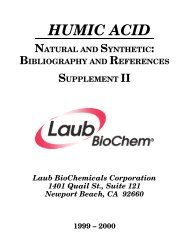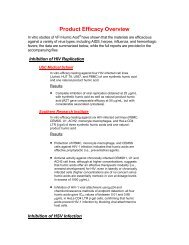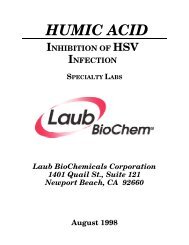HUMIC ACID - Laub BioChem
HUMIC ACID - Laub BioChem
HUMIC ACID - Laub BioChem
- No tags were found...
You also want an ePaper? Increase the reach of your titles
YUMPU automatically turns print PDFs into web optimized ePapers that Google loves.
EP 1 007 068 B1510152025of phosphoric acid (H 3 PO 4 ), and 12.01 grams of acetic acid (CH 3 CO 2 H) with 4 liters of distilled water. Solution C is100% methanol (CH 3 OH). The mobile-phase gradient employed for an HPLC run consists of 40% solution A plus 60%solution B at the beginning, which composition is changed in a linear manner to 100% solution A after 20 minutes. Themobile phase is then changed linearly again to 10% A plus 90% C over the next 5 minutes, which final composition isheld for the purpose of a column wash for the next 35 minutes. The mobile-phase flow rate is 1 milliliter per minute.The detector is UV-Visible, which is set at 340 nanometers. The chart speed is typically 0.5 centimeter per minute.The sample loop size is 5-20 microliters. Solutions are prepared for analysis by dissolving 1-10 grams of dried samplein 100 milliliters of 0.1 normal aqueous sodium hydroxide of pH 8-10.[0083] The chemical processes and separation and isolation procedures of the present invention are suitable forscaleup directly to industrial levels that provide economically acceptable yields. The chemical processes and separationand isolation procedures of the present invention can produce synthetic product yields approaching 100%. More typically,approximately 0.08 to 0.65 g of synthetic humic acid can be produced from 10 millimoles of starting organiccompound or compounds in 300 ml. These procedures can be scaled up to pharmaceutical production scales employing10,000 to 20,000 liters or more of initial solution containing the starting organic compound or compounds. A total yieldof between approximately 2.7 and 21.7 kg of synthetic humic acid can be achieved utilizing a 10,000 liter thermallyjacketed stainless steel tank and a concentration of starting organic compound of 10 millimoles per 300 ml. A singleanti-viral treatment may employ milligram amounts of synthetic humic acid. 20 kg of synthetic humic acid represents2million units of anti-viral product at 10 mg per unit. Even at a treatment cost of $ 0.10 per unit, this represents $200,000 of synthetic humic acid. Since the starting organic compounds utilized in the present invention are relativelyinexpensive, the synthesis yields of the chemical processes and separation and isolation procedures of the presentinvention are economically very acceptable.[0084] Examples 1 through 9 are illustrative of the variety of starting organic compounds that can be employed inthe process of the present invention. It was not considered necessary to carry out all steps of the process of the presentinvention to illustrate starting compound variety. More particularly, Examples 1 through 9 are illustrative of all steps ofthe process of the invention with the exception of step E).EXAMPLE 1303540[0085] Preparation of a synthetic humic acid from 2,5-dihydroxybenzoic acid (gentisic acid). The starting organiccompound is shown in Table 1, and consists of R, = -CO 2 H, R 2 ,R 5 =-OH,and R 3 ,R 4 ,R 6 =-H. 1.55 grams (10 millimoles)of gentisic acid is dissolved in 300 milliliters of 0.1 Normal aqueous sodium hydroxide (NaOH). The solution pH isadjusted to 8.5 with 6 Normal HCl. 0.54 gram of sodium periodate (NaIO 4 ;2.5 millimoles) is added, and the solutionis placed in a water-bath at 50° Cfor 30 minutes. The solution is allowed to stand at room temperature overnight. Anyprecipitate is removed by centrifugation. The solution is dialyzed with a 3,000-dalton cut-off flow-through open-channelor screen membrane system (Pall Filtron: Ultrasette® 7 Tangential Flow Device or Mini-Ultrasette® 7 Tangential FlowDevice used with a Pall Filtron Ultralab® 7 Specialized Pump and Reservoir System) to a conductivity of 30 microsiemensor less against distilled water. The dialysis apparatus is then used to concentrate the solution to about 200milliliters. The solution can be saved at this point for further use as an aqueous solution; or it can be freeze-dried to apowder. (0.05-0.2 gram of mannose or other suitable carbohydrate can be added to the solution prior to freeze-dryingto reduce static electricity effects associated with the freeze-dried powder.) The yield of synthetic soil extract is 0.2 gram.[0086] The following examples 2-9 employ the synthesis procedure of Example 1 beginning with the adjustment ofsolution pH.4550EXAMPLE 2[0087] Preparation of a synthetic humic acid from 3,4-dihydroxyphenylacetic acid (homoprotocatechuic acid). Thestarting organic compound, 3,4-dihydroxyphenylacetic acid, is shown in Table 1, and consists of R 1 =-CH 2 CO 2 H, R 3 ,R 4 =-OH,and R 2 ,R 5 ,R 6 =-H. 1.68 grams (10 millimoles) of homoprotocatechuic acid is dissolved in 300 milliliters of0.1 Normal aqueous sodium hydroxide (NaOH). The remaining procedure follows that of Example 1. The yield ofsynthetic soil extract is 0.24 gram.EXAMPLE 355[0088] Preparation of a synthetic humic acid from dl-(3,4-dihydroxyphenyl)hydroxyacetic acid (dl-3,4-dihydroxymandelicacid). The starting organic compound, dl-(3,4-dihydroxyphenyl)hydroxyacetic acid is shown in Table 1, and consistsof R 1 =-CH(OH)CO 2 H, R 3 ,R 4 =-OH,and R 2 ,R 5 ,R 6 =-H. 1.84 grams (10 millimoles) of dl-3,4-dihydroxymandelicacid is dissolved in 300 milliliters of 0.1 Normal aqueous sodium hydroxide (NaOH). The remaining procedure followsthat of Example 1. The yield of synthetic soil extract is 0.08 gram.19










